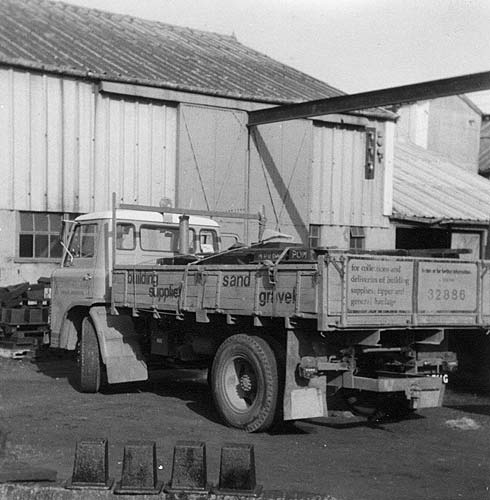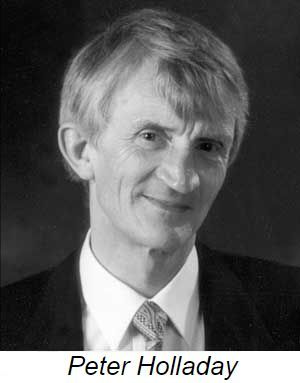

Chapter 10 was written by my father sometime after 1988 as a Postscript to the original 1961 Golden Hammer chapters 1 – 9. It covers developments since 1961 including the closure of the Foundry up to the formation of Garton King Appliances in 1980, which is covered in a new Chapter 11.
In 1964 Beatrice Holladay died, whilst on holiday, on the front at Exmouth, having retained her faculties as well as her directorship and active interest in the firm to the end. The same obituary could well have been given of her as for Jane Kingdon who also died at Exmouth almost 150 years earlier.
In 1968 Peter Holladay came to join his father and uncle in the firm. He had obtained a first class degree in Engineering at Cambridge and was a Scholar of Corpus Christi College, and having musical abilities as well, he had first joined the B.B.C. as an engineer. However, much as he enjoyed the work, there were periods of inactivity and promotion largely depended on dead men’s shoes. He, therefore, asked to join the family business. His contribution over the next few years was considerable as a practical engineer, having previous to Cambridge, worked for twelve months in the engineering works of Ludwig von Rolle at Balsthal in Switzerland. He also soon acquired an ability to manage office administration and finance, and if times had been more favourable, he would have been an obvious successor to take control.
In 1971 Michael Alec Holladay, the son of A. H. Holladay, joined his father in the appliance side of the business. He had previously been employed on the sales side of a firm of Builders’ Merchants in Kent, so had a useful background to help in expanding the sales in this field.
During the period 1960 – 1980, Henry Holladay had, like his predecessor, become interested in local affairs and government. He was a City Councillor from 1966 to 1972 when local government was re-organised. In the later years he was chairman of the City Planning Committee when several major rebuilding schemes were initiated, one of these being the redevelopment of the Guildhall area. This was an unusual coincidence since it ended the arguments which had gone on since 1937 when Garton & King were forced to leave Waterbeer Street and go to Tan Lane, the area being acquired by the City Council then for a Civic Centre.
Alec Holladay had also taken on duties in respect of some of the Exeter Charities, as well as being a Governor of the Maynard School where his mother had been educated and later was Treasurer of the Old Girls Society.
Both brothers were also members of the sole remaining Trade Guild on Exeter, viz.: The Incorporation of Weavers, Fullers and Shearmen, who still operate from their Tuckers’ Hall, Fore Street, built in 1471. Henry Holladay was also a member of the Worshipful Company of Founders of the City of London, and a Freeman.
In 1973, because of the disadvantages of being a large firm when in reality a collection of several small units in different trades – Foundry & Engineering – Heating & Domestic Engineers – Kitchen Appliance Installers – Electricians etc., it was decided to divide the company into two units. It had been found that exemptions and other reliefs and grants were available to small units in the separate trades from government and similar bodies, which were not available to the single larger unit, as well as other problems.
Another factor was that it was realised that with advancing years of the senior directors, the problems of Death Duties, etc. were likely to arise and it might become necessary to realise the whole or part of the business. The mixed activities of the company, whilst suiting the present members, might not be so attractive to a potential purchaser or fit in with another company for amalgamation.
It was arranged that Garton & King Ltd continued the Foundry and Engineering business, whilst a new company – Garton King Appliances Ltd took over the premises at 19 North Street and the activities of Kitchen Appliances and Domestic Engineering. The new company’s nominal share capital of £100 was held by Alec Holladay and his son Michael Holladay, both being actively engaged in that part of the business. For the time being Garton & King Ltd provided additional finance and administrative services for the new company. The two companies continued side by side with the same people doing the same jobs, but a part under a new name.
Peter Holladay was taking more responsibility in the development of the engineering side. A number of mechanised improvements in the foundry were introduced, but it was realised that considerable modernisation would, after 35 years in the Tan Lane premises, be needed and financial reserves were being made for this. The products were basically the same, e.g. municipal castings, engineering castings, gears, etc. and whilst the multiplicity of customers and their individual patterns was being reduced as the customers themselves amalgamated or were taken over, reorganisation of local government authorities who each ordered on their own account. Whilst large single orders and the simplification of variety could lead to lower prices and costs, the conveniences and economy in dependent operations obtained with quick local suppliers is very difficult to quantify. On the other hand the reduction in the price of a large contract is obvious to the dullest councillor. Price became the criterion with bulk buying so that a fraction of 1% could mean the gain or loss of a contract for a whole year or longer, which might represent a large proportion of a firm’s total output.
Initially the firm was confident that adequate finance would be available to finance the improvement programme, which was then estimated at £150,000 - £200,000 over 2 to 3 years, but at the critical time when the decision on those schemes had to be made, a number of adverse factors were beginning to appear. Inflation was rising so that the final cost was likely to be substantially larger, interest rates were rising, the future market for products was not thought to be buoyant and competition was increasing.
The view was expressed by Peter Holladay who had compiled the data, that he did not think there would be sufficient market available at a price that would justify the expenditure, especially since once committed to the schemes it would be difficult to withdraw at any stage. The directors after examination agreed, and as an alternative began to explore the possibility of sale or amalgamation. In fact a buyer was found and negotiations were proceeding when it was discovered that the main negotiator was an undischarged bankrupt, and the board comprised mostly his wife and daughters with similar initials to his own!

Last Delivery
The stage had been reached where the employees had already been informed of the probable sale and when it was called off there was virtually no alternative but to implement the redundancy notices and close down the activity.This was Christmas 1977. Instead of the expected anger, many welcomed the decision, since redundancy payments were substantial in view of the long service of many employees, and others retired.
It must be said that the decision to close was encouraged by the burden of increasing costs and frustration due to new legislation, much of it well intentioned but complicated in its application. The industry had consistently suffered from a low level of return on its capital, dictated by the competition of too large a plant capacity compared with the market. Before the 1939 war, costs were based on a general level of operation of a foundry at 55 – 70% capacity. At the end of the war most firms were operating at 75 – 85% capacity. At this period various controls were enforced on increases in prices for contracts, based on this high level of activity. When the market dropped in volume by only a small fraction firms soon found they were operating at or below their break-even point. Again many firms were basing costs on historical prices for plant depreciation. The plant and buildings had been bought at much lower than current prices, often with government or tax subsidies. All this kept prices down and when renewals and modernisation was needed there was insufficient money to justify the expense. Inflation compounded this problem, especially when inflation itself was rising.
The other factor that finally led to the decision to close down and wind up the company, rather than use its resources for some other activity, was the situation of the senior members of the Holladay family. They were both approaching retiral age or at least reduced activity. Because  profits had been ploughed back into the company, neither had taken a large salary, some provision had been made for pensions, again inflation had made adequate rangements inadequate by the time of retiral. The accountants advised that the only way to remedy the situation was either to sell the shares or to go into a Member’s Voluntary Liquidation, where certain reliefs were given to owner/pensioners. To sell the shares in a private company we had already found difficult if not impossible.
profits had been ploughed back into the company, neither had taken a large salary, some provision had been made for pensions, again inflation had made adequate rangements inadequate by the time of retiral. The accountants advised that the only way to remedy the situation was either to sell the shares or to go into a Member’s Voluntary Liquidation, where certain reliefs were given to owner/pensioners. To sell the shares in a private company we had already found difficult if not impossible.
The run-down took place and the last castings were made in September 1979 and the stock, plant and buildings were disposed of very effectively by Peter Holladay, with all debts collected an adequate return was made to the members for the gold sovereigns invested by the Holladay family. The final liquidator’s meeting was in May 1981.
Looking back it is perhaps some consolation to find that the decisions made were the correct ones, inasmuch that other foundries around Exeter and elsewhere have had to close. By being made to face the problems early, Garton & King Ltd enabled employees to find other jobs or retire, and the results of years of endeavour not wasted.
Next: Chapter 11
Top of Page
See also:
Personalities — Products — AGA
Sitemap / Contents